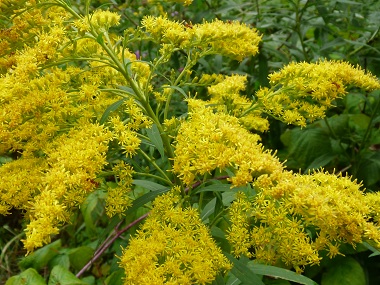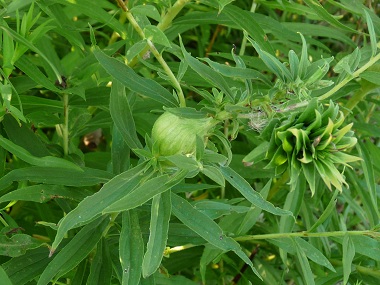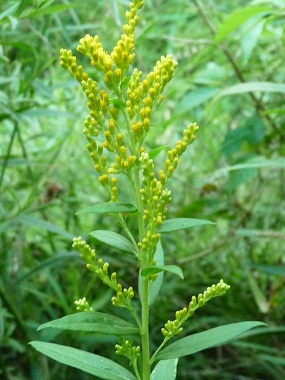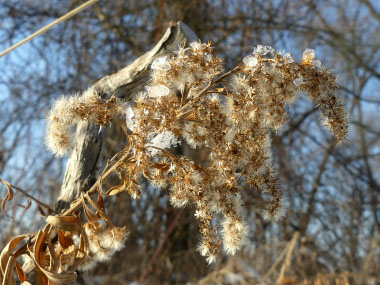








For comprehensive information (e.g. nutrition, health benefits, recipes, history, harvesting tips, etc.) please check out our Goldenrod PDF magazine.
Goldenrod is a perennial plant that is well-known for its healing properties. It reproduces through its roots, bulbs, stems and by its seed, and does not actually cause seasonal allergies as many tend to believe. No one is, no one can be, allergic to this pollen. Why? For starters, goldenrod produces virtually no pollen (it is actually pollinated by insects). Only wind-pollinated plants such as Ragweed (which blooms at the same time as goldenrod) can cause allergic reactions. Currently, there are actually 140 varieties of goldenrod; therefore it has a unique adeptness in crossbreeding with other plants. All varieties are equally nutritious and boast many health benefits. It can be used fresh or as a dried herb to make tea (although it is bitter), or as a fluid extract, tincture, or in capsules. Nebraska declared a type of goldenrod (Soldiago gigantea) as the state flower in 1895.
Distinguishing Features
Long wood-like stems with spiky tooth like parts which are widely-spaced, yellow flowers that grow in thick clusters.
Flowers
Goldenrod flowers grow as an inflorescence in a broad or occasionally narrow pyramidal panicle. They can be anywhere from 5 to 40 cm (2 to 16") high and nearly as wide. There are several to many horizontal branches, the upper sides of which carry numerous, densely-crowded small heads of golden yellow flowers. Each individual flower head measures about 3 mm (1/8") long and wide. This plant flowers from mid-July to September.
 Fields
of Nutrition has medicinal benefits and vitamin/mineral content of Goldenrod.
Fields
of Nutrition has medicinal benefits and vitamin/mineral content of Goldenrod.
Leaves
There can be wide variations in characteristics, but generally, goldenrod leaves are about 10 cm long and 2 cm wide, tapering to a point at the tip and narrowing at the base, with no leaf stem and small teeth around the edges. Three veins run parallel from near the base of the leaf. The underside of the leaf is hairy, especially along the veins and the upper side has a rough texture.
Height
Most plants average 1 metre in height.
Habitat
There is no shortage of goldenrod in September and October. This yellow plant can be found in moist locations, forests, fields, roadsides, compost piles, cultivated fields, and orchards throughout Canada, the U.S., and across the world.
Edible Parts
All aerial parts of the plant can be used. The flowers are edible and make attractive garnishes on salads. Flowers and leaves (fresh or dried) are used to make tea. Leaves can be cooked like spinach or added to soups, stews or casseroles, and can also be blanched and frozen for later use in soups, stews, or stir fry throughout the winter or spring.
Other Name
Canadian Goldenrod.
To support our efforts please browse our store (books with health benefits, etc.).
Winter Survival Food Handbook

PDF Plant Magazines
Types of Wild Food
Geographic Zones Seasons
Disclaimer
EdibleWildFood.com is informational in nature. While we strive to be 100% accurate, it is solely up to the reader to ensure proper plant identification. Some wild plants are poisonous or can have serious adverse health effects.
We are not health professionals, medical doctors, nor are we nutritionists. It is up to the reader to verify nutritional information and health benefits with qualified professionals for all edible plants listed in this web site. Please click here for more information.
Why Edible Wild Food?
- Food costs are rising
- Free, wild food is readily abundant
- Wild food adds nutrition to your diet
- Wild food can help treat various medical conditions







